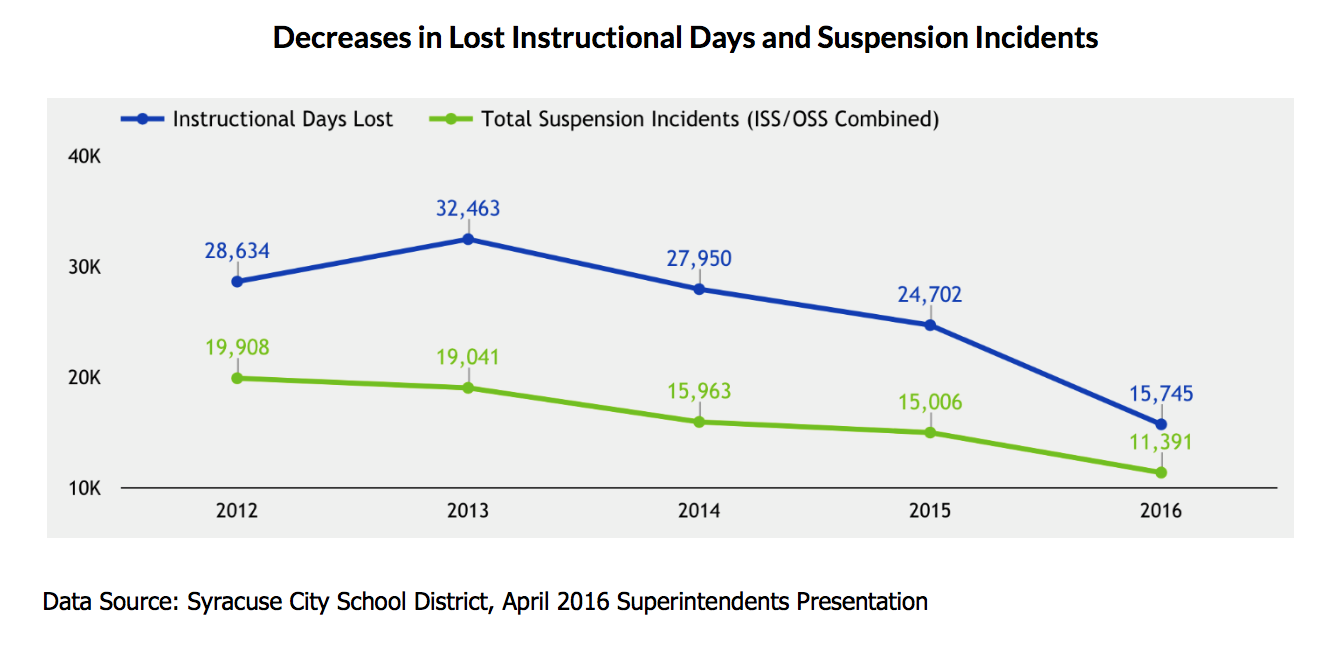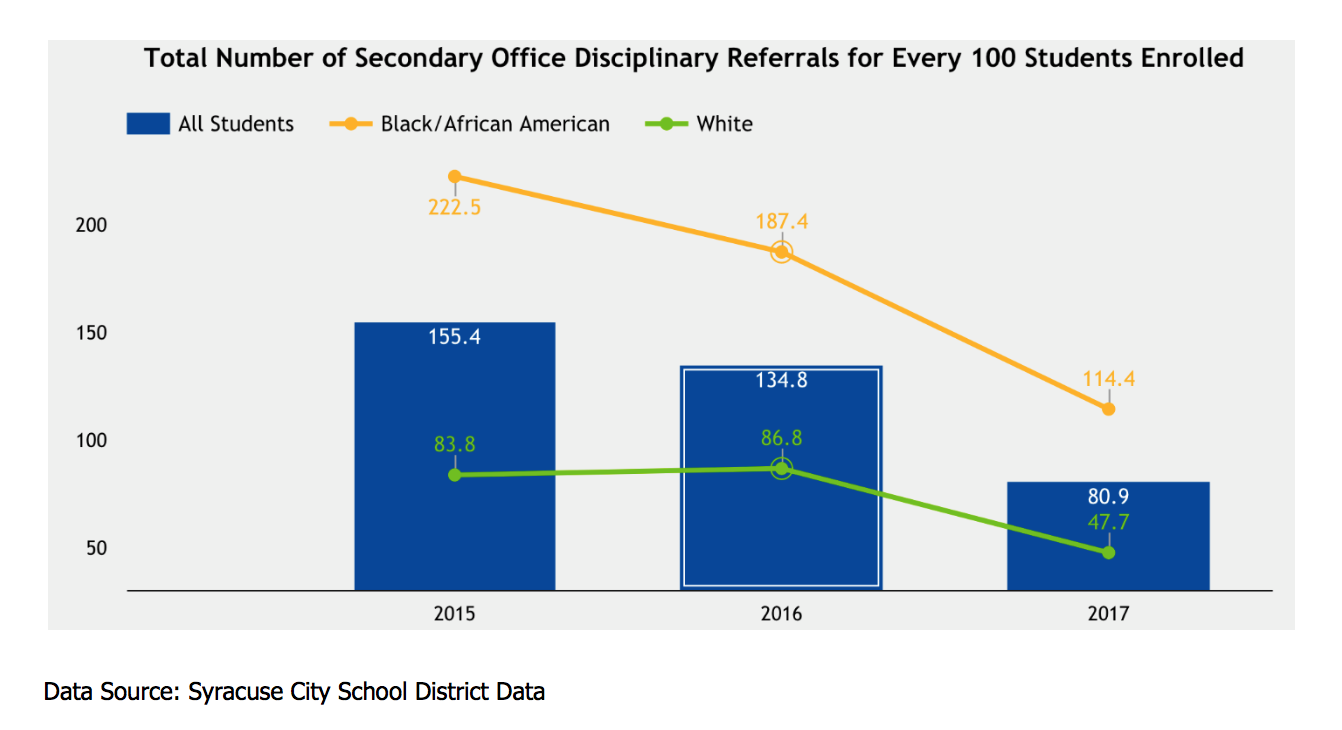The Impact of Developing and Implementing a Code of Conduct, Character, and Support in the Syracuse City School District
The Syracuse City School District (SCSD) in central New York State is a richly diverse district that serves over 19,000 students in 38 schools. Three racial groups make up 85 percent of the population: Black/African American (49 percent), White (22 percent), and Hispanic/Latino (14 percent). Students in Syracuse speak more than 80 languages; 3,500 are English language learners. Over 86 percent are economically disadvantaged, and 21 percent are special education students.

The Challenge
A 2013 UCLA Center for Civil Rights Remedies report showed that Syracuse was suspending students at the rate of 30.8 percent compared to the national average of 11.3 percent. Disproportional suspension of students for the same infractions from certain subgroups, such as Black/African American and special education students, was also significantly higher than national averages. The New York State Attorney General’s office conducted an investigation. Then-SCSD superintendent, Dr. Sharon Contreras, and district leaders were deeply concerned about the suspension rates and took urgent and strategic steps within the district, and with external partners, to plan and implement ways to tackle the problem.
The Code of Conduct, Character, and Support
In 2014, SCSD partnered with Engaging Schools to facilitate a collaborative process to recalibrate the District’s Code of Conduct. The process involved a 50-member task force made up of a wide variety of district leaders, school staff, parents, and community members. The nine-month process culminated in a Code of Conduct, Character, and Support that was fair, respectful, accountable, restorative, and viable. The Syracuse school board approved the new Code in September 2014.
Orientation to the new Code followed. Engaging Schools facilitated institutes for school leadership teams to develop plans for implementation and provided training on the revised Code to approximately 3,000 SCSD employees during the 2014-15 school year. The District then took many steps to implement the Code.
Engaging Schools supported various implementation activities over subsequent school years. These included:
- Helping the district and schools design Intervention Centers.
- Coaching Student Support Teams on policies, protocols, and processes to support students in need of Tier 2 and Tier 3 interventions.
- Facilitating professional learning sessions for teachers and instructional leaders in 16 schools on “Creating a Vibrant Classroom Climate and Culture.”
- Partnering with six schools to: 1) support implementation of our Engaged Classrooms approach, including professional learning for teachers and instructional leaders in classroom management, discipline, and engaging instruction; 2) design and implement intervention centers to support students with chronic academic and behavioral concerns; 3) support Student Intervention Teams on designing a case management structure to help students in need of Tier 2 and Tier 3 interventions.
- Facilitating diagnostic processes with seven schools to assess their public spaces for safety as well as for a sense of belonging and caring for students, families, and staff.
The Results
This support had a positive impact on the way that SCSD addressed behavior concerns and discipline issues. Over a three-year period, the district achieved significant reductions in:
- Suspension incidents (in-school and out-of-school)
- Office disciplinary referrals
- Lost instructional time
- Disproportional use of exclusionary discipline
In March 2015, Superintendent Contreras participated in a Congressional briefing on exclusionary and disproportional discipline hosted by Rep. Bobby Scott (D-VA) and facilitated by Engaging Schools Executive Director Larry Dieringer. Dr. Contreras stated that in the 2012-2013 school year, more than 32,000 instructional days had been lost in SCSD due to suspension (both in-school and out-of-school). By the 2015-2016 school year, after the new Code was launched and implementation was underway, this number had dropped by half. In this same timeframe, the number of district-wide in-school and out-of-school suspensions combined dropped by over 40 percent.

As teachers learned promotion and prevention strategies during Code implementation, the District also saw a significant reduction in the use of office disciplinary referrals (ODRs) which contribute to lost learning time. Please see the chart below for more details about reductions in ODRs.
In addition to implementing restorative and accountable discipline practices to reduce the overall use of suspensions and ODRs, SCSD also sought to decrease the disproportional use of exclusionary discipline that impacted certain sub-groups of students more than others. The discipline disproportionality gap is a hard reality to change in schools nationwide. Yet, in SCSD, during the 2014-2015 to 2016-2017 period, a significant improvement occurred in the disproportionality gap between Black/African American students and White students in the use of ODRs in secondary schools. Though both groups saw significant decreases in ODRs, the decrease for Black/African American students was significantly larger, narrowing the gap with their White peers. Please note that because Black/African American and White students represent the largest subgroups in SCSD, with 49 percent and 22 percent of the student body respectively, we are focusing on this data.

Most subgroups of students (Black/African American, Hispanic/Latino, White, Female, Male, and English Language Learners) also saw decreases in missed instructional days from out-of-school suspensions between 2015 and 2017. In fact, the largest drop among racial subgroups was experienced by Black/African American students, also contributing to a narrowing of the disproportionality gap with their White peers.
The implementation of a recalibrated Code of Conduct, Character, and Support in the Syracuse City School District resulted in significant shifts away from punishment and exclusionary discipline to policies, systems, and practices that are restorative, fair, and respectful. These shifts contributed to decreases in the overall use of ODRs and suspensions, as well as in their disproportional use with particular subgroups of students, Lost instructional days also decreased. Many other school districts have been inspired by the progress in Syracuse and have begun working with Engaging Schools to recalibrate and implement Codes of Conduct, Character, and Support.

